Comprehensive Report: Diagnosis and Treatment of Stroke
VerifiedAdded on 2023/06/08
|7
|1410
|216
Report
AI Summary
This report provides a comprehensive overview of stroke, a chronic disease caused by blood vessel rupture in the brain. It explores diagnostic methods like CT angiography, blood tests, physical examinations, CT scans, MRI scans, and carotid ultrasounds. The report details various treatment options, including medications such as Alteplase, antiplatelets, anticoagulants, and statins, as well as procedures like thrombectomy and carotid endarterectomy. The report emphasizes the importance of early diagnosis and treatment, highlighting the effectiveness of different interventions for both ischemic and hemorrhagic strokes. The report also includes a review of relevant literature and concludes with a summary of key findings and implications for stroke management.
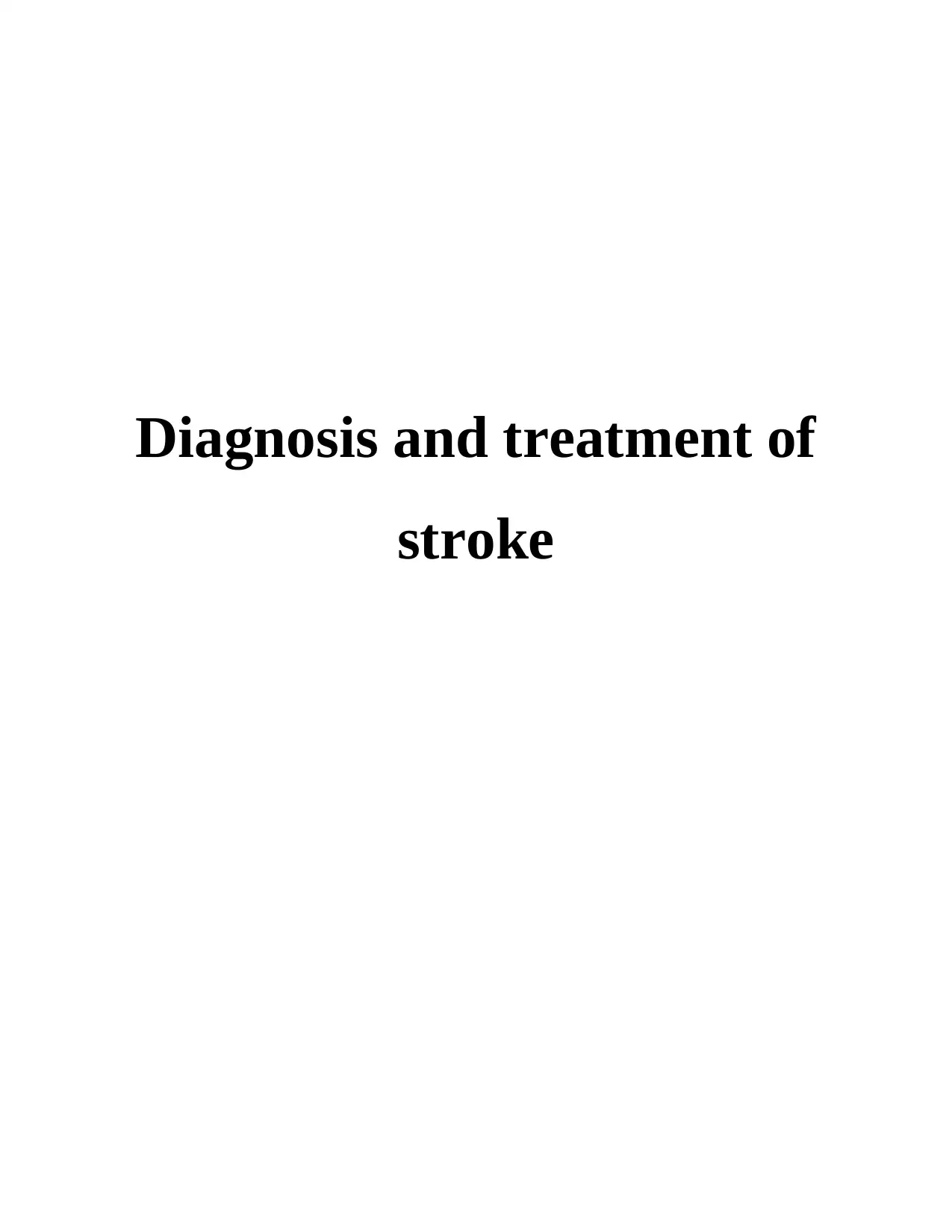
Diagnosis and treatment of
stroke
stroke
Paraphrase This Document
Need a fresh take? Get an instant paraphrase of this document with our AI Paraphraser
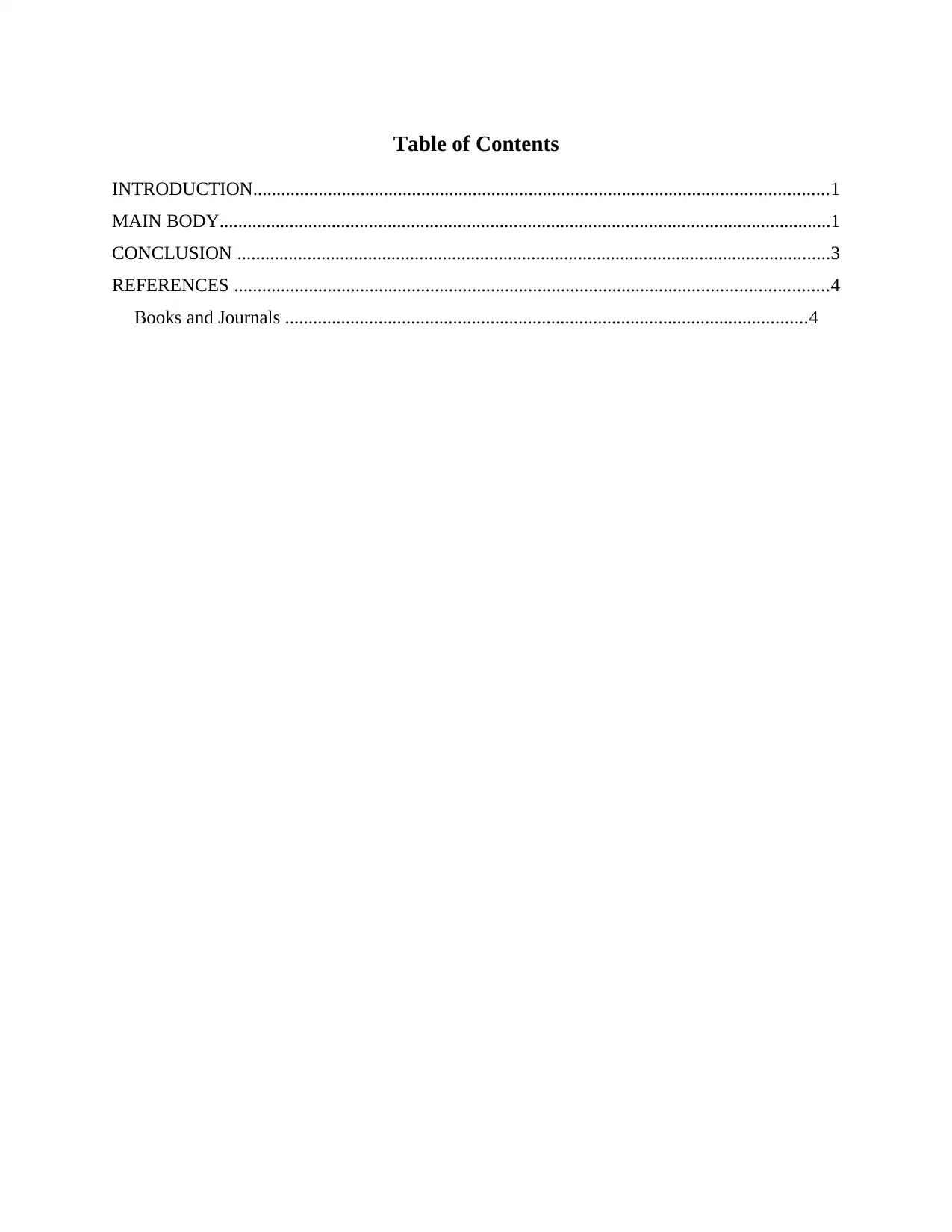
Table of Contents
INTRODUCTION...........................................................................................................................1
MAIN BODY...................................................................................................................................1
CONCLUSION ...............................................................................................................................3
REFERENCES ...............................................................................................................................4
Books and Journals ................................................................................................................4
INTRODUCTION...........................................................................................................................1
MAIN BODY...................................................................................................................................1
CONCLUSION ...............................................................................................................................3
REFERENCES ...............................................................................................................................4
Books and Journals ................................................................................................................4
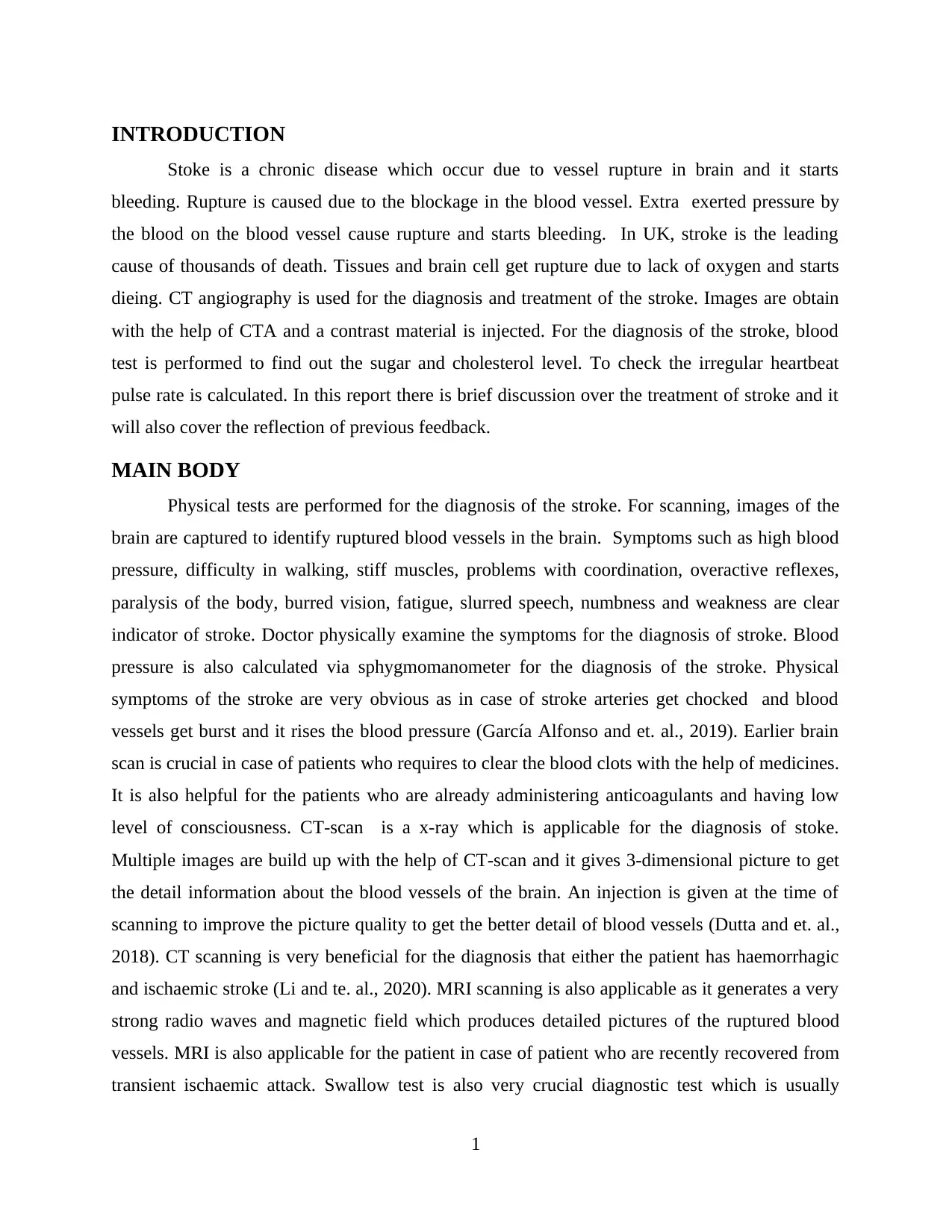
INTRODUCTION
Stoke is a chronic disease which occur due to vessel rupture in brain and it starts
bleeding. Rupture is caused due to the blockage in the blood vessel. Extra exerted pressure by
the blood on the blood vessel cause rupture and starts bleeding. In UK, stroke is the leading
cause of thousands of death. Tissues and brain cell get rupture due to lack of oxygen and starts
dieing. CT angiography is used for the diagnosis and treatment of the stroke. Images are obtain
with the help of CTA and a contrast material is injected. For the diagnosis of the stroke, blood
test is performed to find out the sugar and cholesterol level. To check the irregular heartbeat
pulse rate is calculated. In this report there is brief discussion over the treatment of stroke and it
will also cover the reflection of previous feedback.
MAIN BODY
Physical tests are performed for the diagnosis of the stroke. For scanning, images of the
brain are captured to identify ruptured blood vessels in the brain. Symptoms such as high blood
pressure, difficulty in walking, stiff muscles, problems with coordination, overactive reflexes,
paralysis of the body, burred vision, fatigue, slurred speech, numbness and weakness are clear
indicator of stroke. Doctor physically examine the symptoms for the diagnosis of stroke. Blood
pressure is also calculated via sphygmomanometer for the diagnosis of the stroke. Physical
symptoms of the stroke are very obvious as in case of stroke arteries get chocked and blood
vessels get burst and it rises the blood pressure (García Alfonso and et. al., 2019). Earlier brain
scan is crucial in case of patients who requires to clear the blood clots with the help of medicines.
It is also helpful for the patients who are already administering anticoagulants and having low
level of consciousness. CT-scan is a x-ray which is applicable for the diagnosis of stoke.
Multiple images are build up with the help of CT-scan and it gives 3-dimensional picture to get
the detail information about the blood vessels of the brain. An injection is given at the time of
scanning to improve the picture quality to get the better detail of blood vessels (Dutta and et. al.,
2018). CT scanning is very beneficial for the diagnosis that either the patient has haemorrhagic
and ischaemic stroke (Li and te. al., 2020). MRI scanning is also applicable as it generates a very
strong radio waves and magnetic field which produces detailed pictures of the ruptured blood
vessels. MRI is also applicable for the patient in case of patient who are recently recovered from
transient ischaemic attack. Swallow test is also very crucial diagnostic test which is usually
1
Stoke is a chronic disease which occur due to vessel rupture in brain and it starts
bleeding. Rupture is caused due to the blockage in the blood vessel. Extra exerted pressure by
the blood on the blood vessel cause rupture and starts bleeding. In UK, stroke is the leading
cause of thousands of death. Tissues and brain cell get rupture due to lack of oxygen and starts
dieing. CT angiography is used for the diagnosis and treatment of the stroke. Images are obtain
with the help of CTA and a contrast material is injected. For the diagnosis of the stroke, blood
test is performed to find out the sugar and cholesterol level. To check the irregular heartbeat
pulse rate is calculated. In this report there is brief discussion over the treatment of stroke and it
will also cover the reflection of previous feedback.
MAIN BODY
Physical tests are performed for the diagnosis of the stroke. For scanning, images of the
brain are captured to identify ruptured blood vessels in the brain. Symptoms such as high blood
pressure, difficulty in walking, stiff muscles, problems with coordination, overactive reflexes,
paralysis of the body, burred vision, fatigue, slurred speech, numbness and weakness are clear
indicator of stroke. Doctor physically examine the symptoms for the diagnosis of stroke. Blood
pressure is also calculated via sphygmomanometer for the diagnosis of the stroke. Physical
symptoms of the stroke are very obvious as in case of stroke arteries get chocked and blood
vessels get burst and it rises the blood pressure (García Alfonso and et. al., 2019). Earlier brain
scan is crucial in case of patients who requires to clear the blood clots with the help of medicines.
It is also helpful for the patients who are already administering anticoagulants and having low
level of consciousness. CT-scan is a x-ray which is applicable for the diagnosis of stoke.
Multiple images are build up with the help of CT-scan and it gives 3-dimensional picture to get
the detail information about the blood vessels of the brain. An injection is given at the time of
scanning to improve the picture quality to get the better detail of blood vessels (Dutta and et. al.,
2018). CT scanning is very beneficial for the diagnosis that either the patient has haemorrhagic
and ischaemic stroke (Li and te. al., 2020). MRI scanning is also applicable as it generates a very
strong radio waves and magnetic field which produces detailed pictures of the ruptured blood
vessels. MRI is also applicable for the patient in case of patient who are recently recovered from
transient ischaemic attack. Swallow test is also very crucial diagnostic test which is usually
1
⊘ This is a preview!⊘
Do you want full access?
Subscribe today to unlock all pages.

Trusted by 1+ million students worldwide
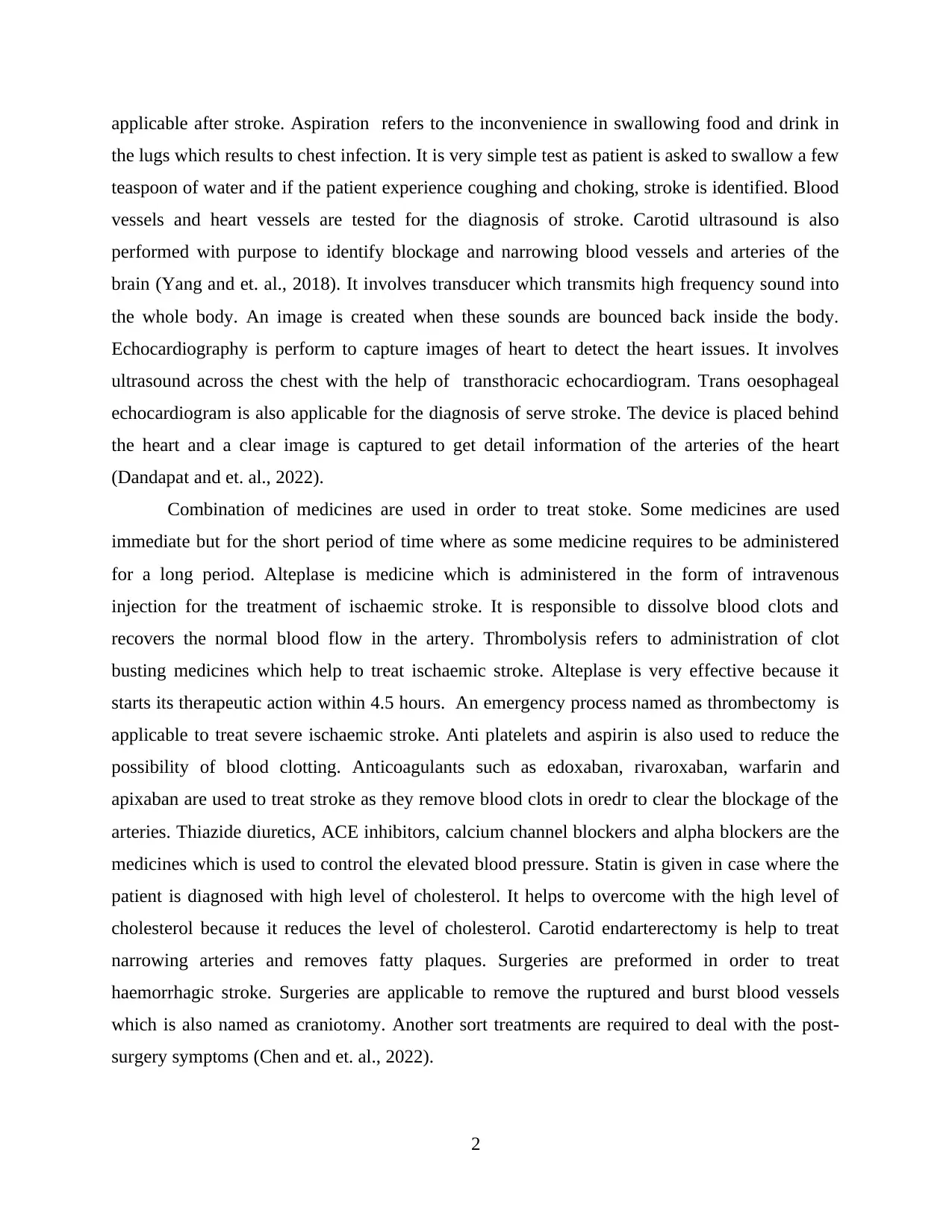
applicable after stroke. Aspiration refers to the inconvenience in swallowing food and drink in
the lugs which results to chest infection. It is very simple test as patient is asked to swallow a few
teaspoon of water and if the patient experience coughing and choking, stroke is identified. Blood
vessels and heart vessels are tested for the diagnosis of stroke. Carotid ultrasound is also
performed with purpose to identify blockage and narrowing blood vessels and arteries of the
brain (Yang and et. al., 2018). It involves transducer which transmits high frequency sound into
the whole body. An image is created when these sounds are bounced back inside the body.
Echocardiography is perform to capture images of heart to detect the heart issues. It involves
ultrasound across the chest with the help of transthoracic echocardiogram. Trans oesophageal
echocardiogram is also applicable for the diagnosis of serve stroke. The device is placed behind
the heart and a clear image is captured to get detail information of the arteries of the heart
(Dandapat and et. al., 2022).
Combination of medicines are used in order to treat stoke. Some medicines are used
immediate but for the short period of time where as some medicine requires to be administered
for a long period. Alteplase is medicine which is administered in the form of intravenous
injection for the treatment of ischaemic stroke. It is responsible to dissolve blood clots and
recovers the normal blood flow in the artery. Thrombolysis refers to administration of clot
busting medicines which help to treat ischaemic stroke. Alteplase is very effective because it
starts its therapeutic action within 4.5 hours. An emergency process named as thrombectomy is
applicable to treat severe ischaemic stroke. Anti platelets and aspirin is also used to reduce the
possibility of blood clotting. Anticoagulants such as edoxaban, rivaroxaban, warfarin and
apixaban are used to treat stroke as they remove blood clots in oredr to clear the blockage of the
arteries. Thiazide diuretics, ACE inhibitors, calcium channel blockers and alpha blockers are the
medicines which is used to control the elevated blood pressure. Statin is given in case where the
patient is diagnosed with high level of cholesterol. It helps to overcome with the high level of
cholesterol because it reduces the level of cholesterol. Carotid endarterectomy is help to treat
narrowing arteries and removes fatty plaques. Surgeries are preformed in order to treat
haemorrhagic stroke. Surgeries are applicable to remove the ruptured and burst blood vessels
which is also named as craniotomy. Another sort treatments are required to deal with the post-
surgery symptoms (Chen and et. al., 2022).
2
the lugs which results to chest infection. It is very simple test as patient is asked to swallow a few
teaspoon of water and if the patient experience coughing and choking, stroke is identified. Blood
vessels and heart vessels are tested for the diagnosis of stroke. Carotid ultrasound is also
performed with purpose to identify blockage and narrowing blood vessels and arteries of the
brain (Yang and et. al., 2018). It involves transducer which transmits high frequency sound into
the whole body. An image is created when these sounds are bounced back inside the body.
Echocardiography is perform to capture images of heart to detect the heart issues. It involves
ultrasound across the chest with the help of transthoracic echocardiogram. Trans oesophageal
echocardiogram is also applicable for the diagnosis of serve stroke. The device is placed behind
the heart and a clear image is captured to get detail information of the arteries of the heart
(Dandapat and et. al., 2022).
Combination of medicines are used in order to treat stoke. Some medicines are used
immediate but for the short period of time where as some medicine requires to be administered
for a long period. Alteplase is medicine which is administered in the form of intravenous
injection for the treatment of ischaemic stroke. It is responsible to dissolve blood clots and
recovers the normal blood flow in the artery. Thrombolysis refers to administration of clot
busting medicines which help to treat ischaemic stroke. Alteplase is very effective because it
starts its therapeutic action within 4.5 hours. An emergency process named as thrombectomy is
applicable to treat severe ischaemic stroke. Anti platelets and aspirin is also used to reduce the
possibility of blood clotting. Anticoagulants such as edoxaban, rivaroxaban, warfarin and
apixaban are used to treat stroke as they remove blood clots in oredr to clear the blockage of the
arteries. Thiazide diuretics, ACE inhibitors, calcium channel blockers and alpha blockers are the
medicines which is used to control the elevated blood pressure. Statin is given in case where the
patient is diagnosed with high level of cholesterol. It helps to overcome with the high level of
cholesterol because it reduces the level of cholesterol. Carotid endarterectomy is help to treat
narrowing arteries and removes fatty plaques. Surgeries are preformed in order to treat
haemorrhagic stroke. Surgeries are applicable to remove the ruptured and burst blood vessels
which is also named as craniotomy. Another sort treatments are required to deal with the post-
surgery symptoms (Chen and et. al., 2022).
2
Paraphrase This Document
Need a fresh take? Get an instant paraphrase of this document with our AI Paraphraser
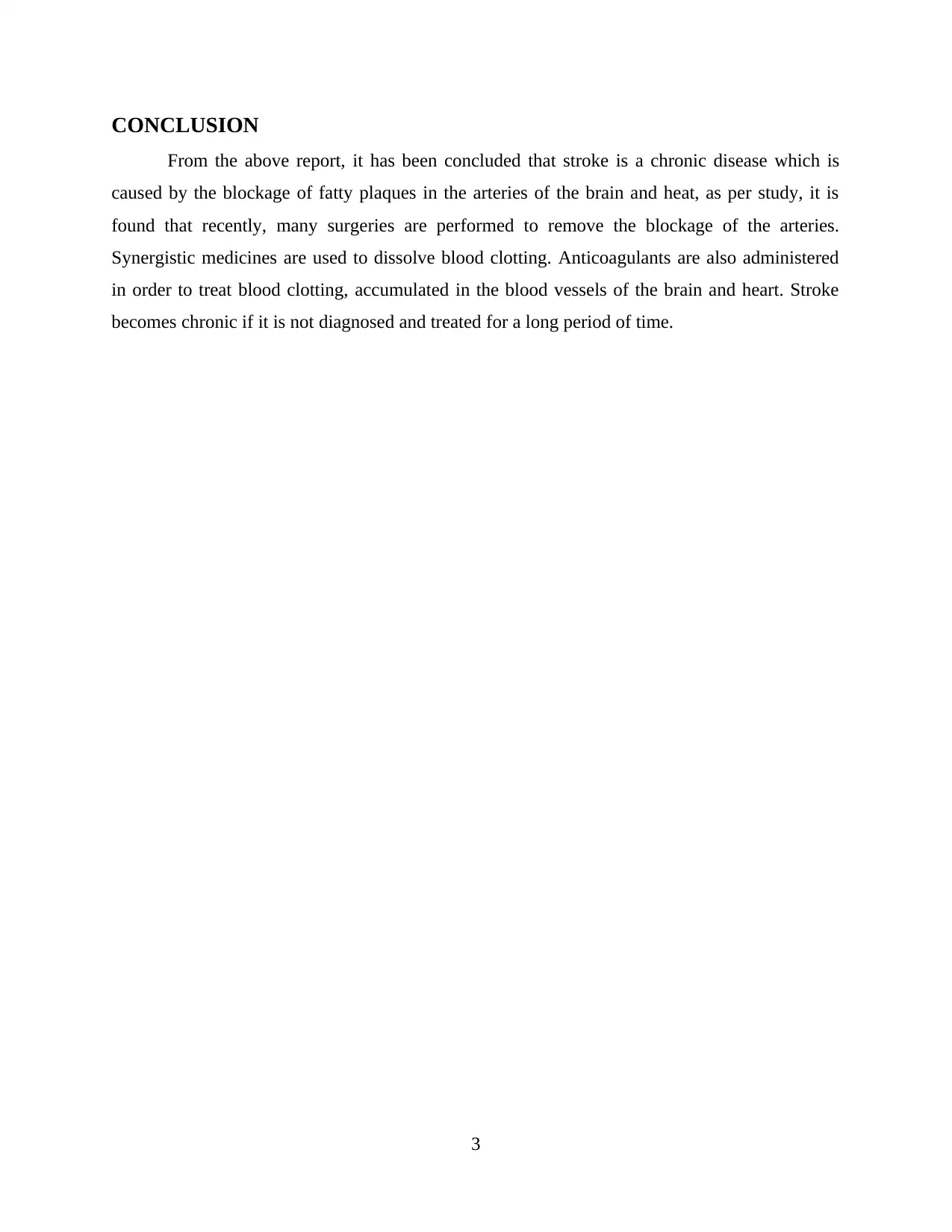
CONCLUSION
From the above report, it has been concluded that stroke is a chronic disease which is
caused by the blockage of fatty plaques in the arteries of the brain and heat, as per study, it is
found that recently, many surgeries are performed to remove the blockage of the arteries.
Synergistic medicines are used to dissolve blood clotting. Anticoagulants are also administered
in order to treat blood clotting, accumulated in the blood vessels of the brain and heart. Stroke
becomes chronic if it is not diagnosed and treated for a long period of time.
3
From the above report, it has been concluded that stroke is a chronic disease which is
caused by the blockage of fatty plaques in the arteries of the brain and heat, as per study, it is
found that recently, many surgeries are performed to remove the blockage of the arteries.
Synergistic medicines are used to dissolve blood clotting. Anticoagulants are also administered
in order to treat blood clotting, accumulated in the blood vessels of the brain and heart. Stroke
becomes chronic if it is not diagnosed and treated for a long period of time.
3
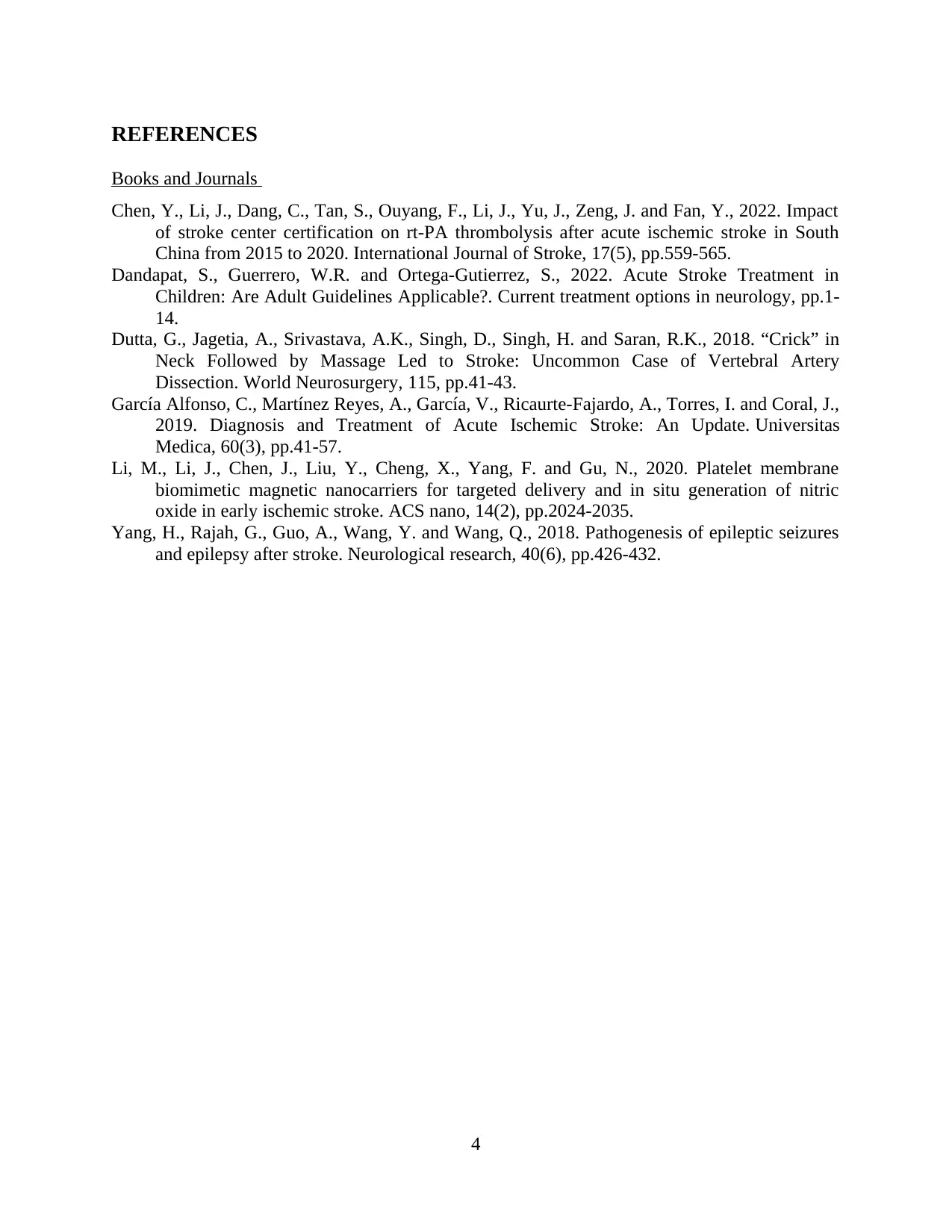
REFERENCES
Books and Journals
Chen, Y., Li, J., Dang, C., Tan, S., Ouyang, F., Li, J., Yu, J., Zeng, J. and Fan, Y., 2022. Impact
of stroke center certification on rt-PA thrombolysis after acute ischemic stroke in South
China from 2015 to 2020. International Journal of Stroke, 17(5), pp.559-565.
Dandapat, S., Guerrero, W.R. and Ortega-Gutierrez, S., 2022. Acute Stroke Treatment in
Children: Are Adult Guidelines Applicable?. Current treatment options in neurology, pp.1-
14.
Dutta, G., Jagetia, A., Srivastava, A.K., Singh, D., Singh, H. and Saran, R.K., 2018. “Crick” in
Neck Followed by Massage Led to Stroke: Uncommon Case of Vertebral Artery
Dissection. World Neurosurgery, 115, pp.41-43.
García Alfonso, C., Martínez Reyes, A., García, V., Ricaurte-Fajardo, A., Torres, I. and Coral, J.,
2019. Diagnosis and Treatment of Acute Ischemic Stroke: An Update. Universitas
Medica, 60(3), pp.41-57.
Li, M., Li, J., Chen, J., Liu, Y., Cheng, X., Yang, F. and Gu, N., 2020. Platelet membrane
biomimetic magnetic nanocarriers for targeted delivery and in situ generation of nitric
oxide in early ischemic stroke. ACS nano, 14(2), pp.2024-2035.
Yang, H., Rajah, G., Guo, A., Wang, Y. and Wang, Q., 2018. Pathogenesis of epileptic seizures
and epilepsy after stroke. Neurological research, 40(6), pp.426-432.
4
Books and Journals
Chen, Y., Li, J., Dang, C., Tan, S., Ouyang, F., Li, J., Yu, J., Zeng, J. and Fan, Y., 2022. Impact
of stroke center certification on rt-PA thrombolysis after acute ischemic stroke in South
China from 2015 to 2020. International Journal of Stroke, 17(5), pp.559-565.
Dandapat, S., Guerrero, W.R. and Ortega-Gutierrez, S., 2022. Acute Stroke Treatment in
Children: Are Adult Guidelines Applicable?. Current treatment options in neurology, pp.1-
14.
Dutta, G., Jagetia, A., Srivastava, A.K., Singh, D., Singh, H. and Saran, R.K., 2018. “Crick” in
Neck Followed by Massage Led to Stroke: Uncommon Case of Vertebral Artery
Dissection. World Neurosurgery, 115, pp.41-43.
García Alfonso, C., Martínez Reyes, A., García, V., Ricaurte-Fajardo, A., Torres, I. and Coral, J.,
2019. Diagnosis and Treatment of Acute Ischemic Stroke: An Update. Universitas
Medica, 60(3), pp.41-57.
Li, M., Li, J., Chen, J., Liu, Y., Cheng, X., Yang, F. and Gu, N., 2020. Platelet membrane
biomimetic magnetic nanocarriers for targeted delivery and in situ generation of nitric
oxide in early ischemic stroke. ACS nano, 14(2), pp.2024-2035.
Yang, H., Rajah, G., Guo, A., Wang, Y. and Wang, Q., 2018. Pathogenesis of epileptic seizures
and epilepsy after stroke. Neurological research, 40(6), pp.426-432.
4
⊘ This is a preview!⊘
Do you want full access?
Subscribe today to unlock all pages.

Trusted by 1+ million students worldwide

5
1 out of 7
Related Documents
Your All-in-One AI-Powered Toolkit for Academic Success.
+13062052269
info@desklib.com
Available 24*7 on WhatsApp / Email
![[object Object]](/_next/static/media/star-bottom.7253800d.svg)
Unlock your academic potential
Copyright © 2020–2025 A2Z Services. All Rights Reserved. Developed and managed by ZUCOL.





